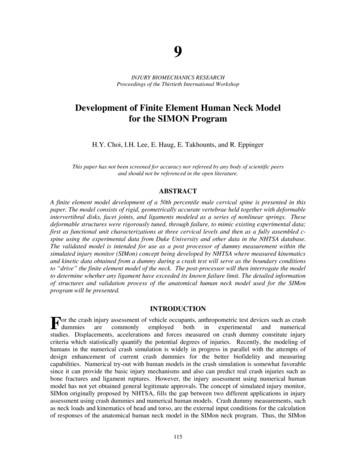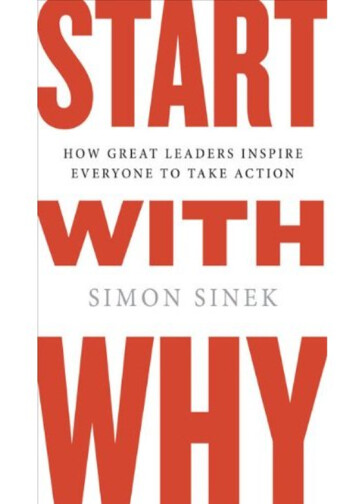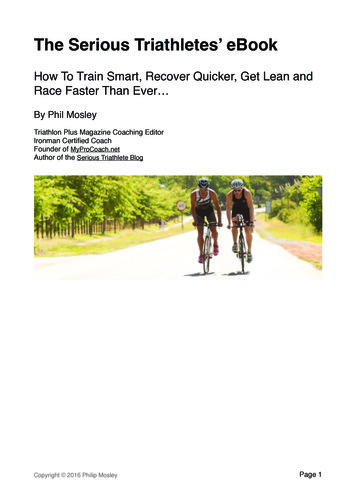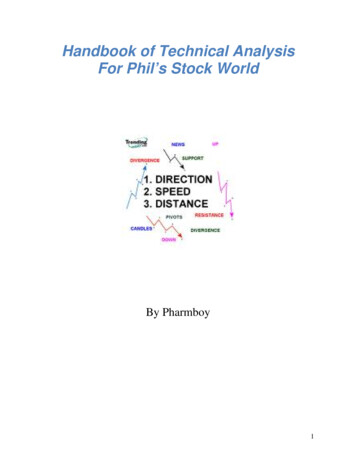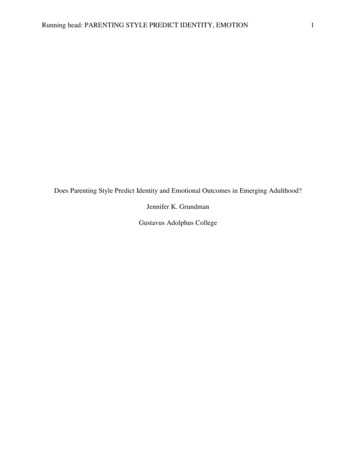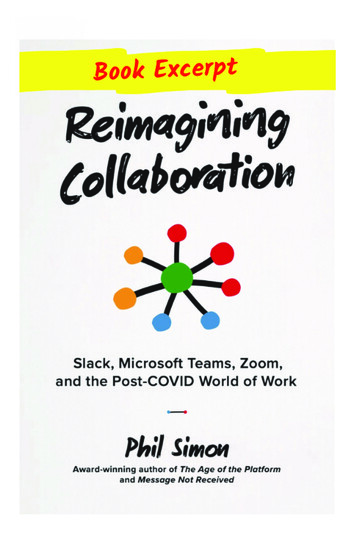
Transcription
Copyrighted MaterialReimagining Collaboration: Slack, Microsoft Teams, Zoom, and the Post-COVIDWorld of WorkCopyright 2021 by Phil Simon. All Rights Reserved.No part of this publication may be reproduced, stored in a retrieval system, ortransmitted, in any form or by any means—electronic, mechanical, photocopying,recording, or otherwise—without prior written permission from the publisher,except for the inclusion of brief quotations in a review.For information about this title or to order other books and/or electronic media,contact the publisher:Motion Publishing www.motionpub.comISBNs:978-0-9829302-2-9 (print)978-0-9829302-7-4 (eBook)Printed in the United States of AmericaCover design: Luke Fletcher www.fletcherdesigns.comInterior design: 1106 Design
Also by Phil SimonZOOM FOR DUMMIESSLACK FOR DUMMIESANALYTICS:The Agile WayMESSAGE NOT RECEIVED:Why Business Communication Is Broken and How to Fix ItTHE VISUAL ORGANIZATION:Data Visualization, Big Data, and the Questfor Better DecisionsTOO BIG TO IGNORE:The Business Case for Big DataTHE AGE OF THE PLATFORM:How Amazon, Apple, Facebook, and GoogleHave Redefined BusinessTHE NEW SMALL:How a New Breed of Small Businesses Is Harnessingthe Power of Emerging TechnologiesTHE NEXT WAVE OF TECHNOLOGIES:Opportunities in ChaosWHY NEW SYSTEMS FAIL:An Insider’s Guide to Successful IT Projects
Praise for“Plenty of business books make us think. Some even inspireaction. Reimagining Collaboration is the rare book that not onlyaccomplishes both, but provides the framework to effect realchange. It is essential reading for anyone leading or managingtoday’s rapidly shifting workplace. Business leaders shouldbuy copies for all of their employees.”—NICK HUZAR, OfferUp CEO“An insightful perspective on the new world of work.Collaboration is more essential than ever, and Phil Simonprovides the roadmap we need.”—DORIE CLARK, author of Entrepreneurial You and executiveeducation faculty, Duke University Fuqua School of Business“We all collaborate, although some do it better than others. We all need to align our talent, technology, and technique appropriately for the times. Phil Simon’s ReimaginingCollaboration will up your game, regardless of your currentlevel of expertise or collaboration tool of choice.”—PROF. TERRI GRIFFITH, Keith Beedie Chair in Innovation &Entrepreneurship, Simon Fraser University“Phil Simon’s latest book not only defines collaboration witha depth and breadth never before seen, it defines the futureof work in tomorrow’s successful organizations. ReimaginingCollaboration is a must-read not only for those leading knowledge management and productivity efforts, but for everybusiness leader in any organization.”—DOUG LANEY, Innovation Fellow, West Monroe Partnersand author of Infonomics: How to Monetize, Manage, andMeasure Information as an Asset for Competitive Advantage
“You will love Reimagining Collaboration, a humor-filledyet perceptive journey into the remarkably collaborative futureof work. Simon’s framework and practical tips will help yourteam move from good to better to best.”—DR. MARY DONOHUE, founder of The Digital Wellness Centerand author of Message Received: 7 Steps to Break DownCommunication“At one time or another, I’ve used many of the tools discussed in this book. I just didn’t fully appreciate the biggerpicture. Reimagining Collaboration made me appreciate thetrue power of these collaborative technologies—especiallywhen used together.”—BRIAN SOMMER, technology industry analyst and author ofDigital With Impact“Solutionists believe that new technologies magicallysolve major challenges by themselves. Of course, they’rewrong. Effective collaboration is a nuanced, multidimensionalproblem—a point that Phil Simon makes in spades. Ultimately,Reimagining Collaboration delivers on its promise: To makereaders not only think differently about this essential subject,but provide a framework for actually doing it.”—MIKE VARDY, founder of Productivityist and author of TheGift of Time
To the frontline workers battling COVID-19.You are true heroes.
“Never attribute to malice that which can beadequately explained by ignorance.”—Hanlon’s Razor
ContentsIntroductionxixPart I:The Collaboration Imperative1Chapter 1:The Evolution of Collaboration3Chapter 2:Collaboration in Context19Chapter 3:The Benefits of Reimagining Collaboration43Chapter 4:Why Email Inhibits Collaboration51Part II:Better Collaboration ThroughTechnology61Chapter 5:Reimagining Workplace Technology63Chapter 6:The Hub-Spoke Model of Collaboration79Chapter 7:How to Select an Internal Collaboration Hub99Chapter 8:Why Collaboration Hubs Can Disappoint117xiii
xivReimagining CollaborationPart III: Moving From Theory to Practice127Chapter 9:129Reviewing Implementation StrategiesChapter 10: Reimagining Business Processes139Chapter 11: Collaboration Killers and How to Handle Them153Chapter 12: The Myths of Collaboration167Chapter 13: Reimagining Communication and HumanResources183Part IV: What Now?195Chapter 14: Why Effective Collaboration Requires LifelongLearning197Chapter 15: The Future of Collaboration207Chapter 16: Recommendations for ReimaginingCollaboration221Conclusion and Parting Words229Thank-You231Suggested Reading233Acknowledgments235About the Author237Index239Endnotes249
ContentsxvList of Figures and TablesFigure 1.1:Percentage of Americans Working Remotely10Figure 1.2:U.S. Cities With Biggest Percentage Gains inNet Arrivals13Figure 1.3:U.S. Cities With Steepest Percentage Declinesin Net Arrivals13Figure 2.1:The Dimensions of Collaboration36Figure 5.1:Zoom’s Insane User Growth67Figure 5.2:Aging in Reverse75Figure 6.1:The Hub-Spoke Model of Collaboration85Figure 6.2:Zoom Zapps85Figure 6.3:Power Automate Template to Post Email toMicrosoft Teams89Figure 7.1:Collaboration Hubs and Diminishing MarginalReturns105Table 7.1:The Three Fields of Enterprise TechnologyAdoption112Figure 12.1: My YouCanBook.me Page173Figure 15.1: Microsoft Teams’ Together Mode216Figure 15.2: Breakdown of Employee Work Preferences219Table 16.1:222Collaboration Maturity ModelFigure 16.1: Tools Matter223Figure 16.2: Size (Probably) Matters224
Internal collaboration hub (n):General-use software application designed to promote effective communication and collaboration. Ideally, all organizational conversations, decisions, documents, and institutionalknowledge exist in a hub. Critically, hubs connect to differentspokes. They enable automation with little-to-no technical skillrequired. Examples of today’s popular hubs include Slack,Microsoft Teams, and Zoom.Spoke (n):Software application designed for a specific purpose. Examplesinclude productivity, content creation, customer-relationshipmanagement, and project management. Spokes can easilyexchange information with hubs, provide status updates, andmore. As a result, employee, group, and organization communication and collaboration markedly improve.
Introduction“You can write a 200-page book about Zoom?”My friend Tess incredulously asked me this question afterI told her that I’d signed a contract to pen Zoom For Dummiesin April of 2020. (In fact, the book ultimately came in at twicethat length because, as I came to learn, Zoom is so much morethan a user-friendly videoconferencing application.)To be fair, Tess’s skepticism wasn’t entirely unfounded.As I would soon learn, she was no outlier. Many peopledidn’t—and still don’t—fully appreciate the true power of today’scollaboration tools—and not just Zoom. My previous book, theequally hefty Slack For Dummies, had evoked similar reactions. Some long-time Slack and Zoom users posted onlinereviews, noting that my book taught them a great deal aboutwhat those technologies could do. Even some employees ateach company echoed that sentiment.I have spent the last quarter-century at the nexus of management, collaboration, technology, and data. As a result, Ihave learned a thing or six about each. For the purposes ofthis book, people generally use workplace collaboration andcommunication tech in limited capacities. New applicationsxix
xxReimagining Collaborationarrive, but they tend not to alter our habits, and certainly notimmediately. And I’m hardly the only person to observe as much.Meet Eugene FubiniEugene Fubini (1913–1997) immigrated from Italy to the UnitedStates in 1939. During his career, he helped create U.S. policyduring the Cold War. He is perhaps most famous for codifyingfour principles. Fubini’s Law states that:1. People initially use technology to do what they donow—but faster.2. Then they gradually begin to use technology to donew things.3. The new technology changes how we live and howwe work.4. These changes to how we live and work ultimatelychange society—and eventually change technology.The operative word here is gradually. As a general rule,when it comes to workplace technology, people of a certainage tend to fight change as long as possible. It takes a blackswan for them to fundamentally change how they work.COVID-19 was such an event.The Struggle (to Adapt) Is RealGo back to March of 2020. Think about how you and yourcolleagues responded when your employer suddenly shut itsdoors. Did that transition go off without a hitch? If so, then,congratulations are in order. You’re one of a relative few.
IntroductionxxiThe struggle to adapt to the new normal was real. It still is.I saw firsthand how woefully unprepared even a purportedlyinnovative institution was for such a dramatic shift in how itsemployees work and collaborate.By way of background, during that surreal period,I was finishing my fourth year as a full-time college professor at Arizona State University’s W. P. Carey School ofBusiness. My home base was the Information Systems (IS)Department.Three facts about COVID-19 and ASU will provide the requisite context. First, oodles of international students attend theschool. In 2017, that number approached 14,000, more thanany other public university.1 At any point and depending ongeopolitical winds, roughly one in five ASU students calls acountry other than the U.S. home.2 For a long time, ASU andother state universities have heavily recruited foreign studentsfor obvious reasons: These students typically pay fees two tothree times higher than their in-state counterparts.3 Chinesestudents are particularly prevalent in Arizona.Second, for the last six years, U.S. News & World Reporthas named ASU the most innovative school in America. 4Its powers-that-be have never been shy about sharing thataccolade with the world. On the contrary, that tagline prominently adorns its website5 as well as many local buses andbillboards. In one example of how it touts its innovation, theschool proudly announced that it had procured an enterpriselicense for the popular collaboration tool Slack in January2019—well before a single documented coronavirus caseanywhere in the world.
xxiiReimagining CollaborationThird, media outlets such as The New York Times reporteddozens of coronavirus cases in China as early as Juneof 2020.6Brass tacks: COVID-19 was coming to American universitiesincluding ASU. It was a matter of when, not if.Let’s take a step back and summarize:1. The most innovative university in the country sports alarge international contingent.2. Many of these students are Chinese and had returnedfrom their homeland in January of 2020, after the winter break.3. ASU had recently purchased a powerful new collaboration tool.4. University leadership conservatively had more thanthree months to war-game the inevitable arrival ofCOVID-19.Against this backdrop, surely ASU could shift all of itscourses online with minimal disruption to faculty and studentsalike, right?From the outside looking in, you might think so.And you would be spectacularly wrong.When ASU announced the indefinite suspension ofin-person classes in the middle of spring break of 2020,utter chaos ensued. It took only a few days for orderlyprocesses, normal activities, and established deadlines todevolve into widespread confusion. Specifically, and in noparticular order:
Introduction xxiiiThe administration’s hastily arranged Zoom and Slacktraining classes didn’t staunch the bleeding. Manyprofessors skipped them because they had other fishto fry. No surprise here. It’s impossible to fix the planewhile it’s in the air. Overall class quality and studentlearning plummeted.* Department-wide webinars left faculty members withmore questions than answers. ASU discouraged thousands of students from returningto their dorms. Some of them could not even retrievetheir textbooks. One student filed a class-action lawsuit claiming breachof contract and demanding tuition and housing refunds.7 Administrators’ guidance to faculty was anything butclear. As but one example, some professors subsequentlyoffered their students pass/fail options. Others refused. Students clamored for exceptions, extensions, anddo-overs—some legitimate, others because coronavirusate their homework.Lest I paint an overly negative picture of my formeremployer, a few disclaimers are in order. First, every institution of higher learning struggled in the immediate wake ofCOVID-19. It’s not like there was a playbook to follow. Theyweren’t opening a local Subway or Arby’s. School presidentswere making things up on the fly.* Department chairs broke precedent and intentionally ignoredstudent evaluations when making decisions to extend offers toexisting non-tenured faculty.
xxivReimagining CollaborationSecond, let’s say that every ASU professor had been proficient in Slack and Zoom. Managing the situation still wouldhave been challenging, given the school’s massive studentpopulation: 90,000 in-person and 38,000 online at the endof 2019.8The Bill for Years of Inertia FinallyComes DueSince the fall of 2017, I had used Slack in all of my classes.* Ihad encouraged my colleagues to use it as well, admittedlywithout much success. During my tenure at ASU, only ahandful of my IS colleagues had warmed to it. I suspect thatprofessors in the Philosophy and English departments sportedeven lower adoption rates.“We shape our tools, and, thereafter, they shape us.”—Marshall McLuhanAlthough disappointing, at least the party line was consistent. A few times since I had started, I asked departmentdecision-makers why we relied exclusively on ’90s-style emailand attachments for internal communications, especially afterASU had purchased a far better tool. After all, we were the ISdepartment, damn it. Shouldn’t we be setting an example forthe rest of the university by embracing Slack?They hemmed and hawed. Fundamentally, they didn’t wantto learn new programs and change their antiquated business* Read my post on the topic at https://bit.ly/hsc-slack.
Introductionxxvprocesses, conditions that I had diagnosed many times in myconsulting career. Professors and staff kept using their emailfor internal communication and “collaboration.”McLuhan was right.The RevelationFast-forward to mid-April of 2020. As finals approached,all things considered, my semester was progressing fairlysmoothly, especially in comparison to those of my colleagues.In part, I could thank my proficiency with Slack and my decisionto continue using it at the beginning of the semester. I didn’thave to introduce my students to a new communication toolin the midst of the chaos. (Also, in the interest of full disclosure, the department had assigned me four online classesthat semester. I had already recorded my requisite videos inJanuary, well before the shit hit the fan.)Outside of the classroom, I was knee-deep in researchingand writing Zoom For Dummies. At that point, I used Slack,Zoom, and Microsoft Teams daily in different capacities—thethree most popular collaboration hubs in the world.I had noticed how the three applications were far moresimilar than dissimilar. Indeed, they shared much of the samecore functionality. It occurred to me that the specific toolsthat organizations, groups, and individuals use to collaboratecertainly matter, just not as much as most people think. (Theonly caveat: As long as they don’t attempt to “collaborate” viaemail, but we’ll tackle that topic in Chapter 4.)Focusing on the features of a specific application certainly made sense when writing a For Dummies book. In
xxviReimagining Collaborationa way, though, that approach obscured a more importantreality: As I witnessed firsthand at ASU, fusing new tools withantiquated habits and business processes didn’t magicallymake groups, departments, or entire organizations morecollaborative. By themselves, applications don’t rewire ourtried-and-true habits.Let me draw a golf parallel. Say that your swing is horrendous. When you take the club back, you don’t know wherethe ball will ultimately land. Buying a pricey new driver won’tmake you any less of a hack. You might even hit the ballfarther out of bounds. Rather, to become proficient or evencompetent at the sport, you’ll have to break your bad habitsand learn new techniques.At that point, the big idea at the center of this book begantaking shape. Compared to my last two, I envisioned a shorter,tool-agnostic text that would offer manifold benefits.What You Should Know From the Get-GoI believe in truth in advertising. To this end, know this:Reimagining Collaboration provokes and challenges its readers. It intentionally questions conventional and deep-rootedassumptions about how we communicate and collaborate atwork, such as: All text-based communication is essentially the same,irrespective of the application used. The tools that people use to communicate and collaborate are inherently personal and don’t affect othersin the organization.
Introduction xxviiAsynchronous communication and collaboration arejust as effective as their synchronous counterparts. It’s technically demanding and time-consuming to stitchtogether different applications.Chapter 12 explores these myths in far more depth.I want you to look at communicating and collaboratingthrough a very different lens. If you do, then you’ll reevaluatea number of things. First up is your existing relationship withworkplace technology. Why do you keep switching back andforth among different applications? Why aren’t all of your toolsconnected—or at least most of them?Beyond that, in all likelihood, you’ll never view your existingbusiness processes in the same way. I suspect that you’ll wantto redesign many of them.In short, this book asks if we can do better.Reimagining Collaboration is conceptual in nature. Inthis way, it represents a vast departure from my recentforays into the For Dummies world. Because of the rapidpace of software updates today, my last two books are onburning planks. This one, however, should hold up for theforeseeable future, regardless of vendors’ changes to theiruser interfaces.In a similar vein, this book is technology agnostic by design.The following pages are equally relevant for employees whowork in Microsoft, Google, Slack, or Zoom shops—or even iftheir companies have not deployed one as of now. If you’relooking for tips on how to use those internal collaborationhubs, you won’t find them here.
xxviiiReimagining CollaborationWho Should Read This Book?In no particular order, I wrote Reimagining Collaboration withthese audiences in mind: Your team, department, or employer sucks at collaboration and internal communication. You’re searching for abetter way to work with your colleagues and partners. You mistakenly believe that effective collaborationentails hitting “Reply All” on an email thread. Your organization has deployed Microsoft Teams,Slack, Zoom, or another internal collaboration hub. Sixmonths later, however, collaboration is still wanting. Your organization or team is thinking of deploying oneof these hubs. You have adopted new, collaborative technologiesand processes at work. You want your colleagues todo the same.If you fall into one of these groups, then ReimaginingCollaboration is right up your alley. I don’t guarantee results,but you will look at collaboration through a new lens.What Will You Learn?This book does not lack ambition. Reimagining Collaborationintroduces a fundamentally different model for workplacecollaboration and communication. You’ll learn how to thinkabout these subjects, as well as technology and businessprocesses, in a holistic way. I don’t just introduce a new model,
Introductionxxixthough. You’ll learn how to put it into action—and how tohandle people who are stuck in their ways.Plan of AttackPart I of this book (“The Collaboration Imperative”) providesan insanely brief history of collaboration, technology, andthe workplace. It contrasts collaboration with adjacent workrelated terms. I make the case that collaboration today mattersmore than ever. Only by eschewing email can we realize thebenefits of true collaboration.In Part II (“Better Collaboration Through Technology”), Iexplain how a new breed of tools that I dub internal collaboration hubs—hence, this book's subtitle—makes it far easierfor employees to work together. The big three are Slack,Microsoft Teams, and Zoom.I also introduce the fulcrum at the center of this book: theHub-Spoke Model of Collaboration. You’ll learn how to easilystitch different applications together without any coding. Bydoing so, you’ll minimize rework, automate tasks, and quicklyget on the same page as your colleagues. Oh, and you’llcommunicate and collaborate much better, too.At its core, Reimagining Collaboration is disruptive. It forcesits readers to think differently about work. It advocates adopting new habits and technologies. In that vein, Part III (“MovingFrom Theory to Practice”) explains its major consequences:Organizations will have to rethink legacy business processesand confront problematic and change-averse employees. I alsooffer suggestions about how to maximize the chance that thenew collaboration hub will take root.
xxxReimagining CollaborationAs you’ll learn in the following pages, neither collaborationhubs nor their spokes are static. They evolve in interestingways. To this end, Part IV (“What Now?”) puts a bow on thebook. I offer advice on how to quickly learn new tools—andnew features of existing applications. I also chime in with somepredictions on the future of collaboration technologies. Theinternal collaboration hubs will become only smarter, moreconnected, and more powerful. I end with some tips designedto improve collaboration and a call to action.I hope that you enjoy Reimagining Collaboration and learna great deal from it.
Contents xv List of Figures and Tables Figure 1.1: Percentage of Americans Working Remotely 10 Figure 1.2: U.S. Cities With Biggest Percentage Gains in Net Arrivals 13 Figure 1.3: U.S. Cities With Steepest Percentage Declines in Net Arrivals 13 Figure 2.1: The Dimensions of Collaboration 36 Figure 5.1: Zoom's Insane User Growth 67 Figure 5.2: Aging in Reverse 75


